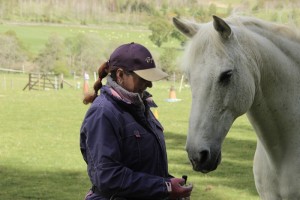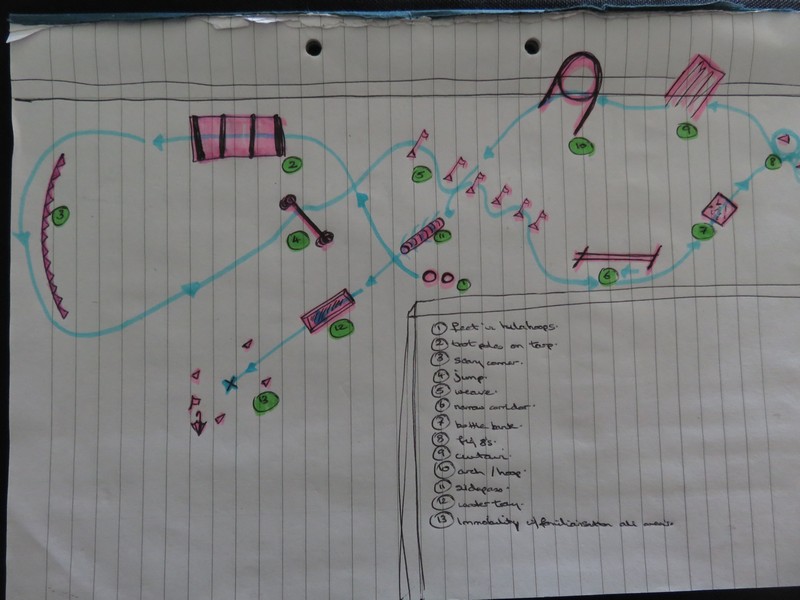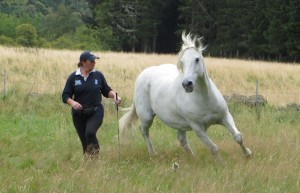STARTING UP AFTER WINTER BREAK

THINGS TO DO ONLINE (and/or at Liberty)
1) FAMILIARISATION:
Halter with savvy / touch horse with hands / stick and string rhythmically / with rope / plastic bag / flag / ball / saddle pad / saddle. In front of horse, beside horse, next to horse, further away and around horse.
From gentle up to extreme familiarisation.
2) MOVE FROM A FEEL / TOUCH – steady pressure:
Back up from chest and nose, up to 20 steps using pulsing pressure and always looking for lightness and NO BRACE in horse.
Move forehand over (keeping hq’s still and also with hq’s moving slightly in a circle), using pulsing pressure – up to a full circle.
Move hindquarters over (criteria as above but keeping fh still).
Head down, using lightness and as much time as needed for understanding. Hand on poll and using light pressure on rope.
Pick up feet using touch/squeeze of chestnut method…working towards being able to pick up all four feet individually from one side.
3) MOVE FROM YOUR FOCUS / INTENT – rhythmic pressure:
Use alpha phases at all times (thought/energy/body cue/tap air in 4 phases up to to tapping horse in a non aggressive way…pulsing pressure).
Slowly and gently disengage hindquarters (up to full circle, criteria as with porcupine)
Move forehand (up to full circle)
Walk backwards with pulsing pressure infront of the horse.
Drive horse to obstacles/touch it – point 2 point, using driving game with you next to horse by neck/shoulder.
4) DRAW & DRIVE – transitions:
With gently pulsing alpha phases and NO WIGGLING of rope unless blocking unwanted moves.
Backup horse to end of 12′ and then 22′ lines and draw with line still on the ground.
Yo-yo you and horse together in sychronised moves, keeping at least 6 paces between you both at all times.
Back and draw between cones, over and back with poles, stable doors, gateways and lower head and back up (making sure no brace or resistence in head down, teach slowly again)
5) CIRCLES:
12′ line – walk / up to 6 continuous laps (in a calm, relaxed manner, no stops until you say so with a DHQ)
12′ line – trot / up to 4 continuous calm laps
22′ line – walk / 8 laps (as above)
22′ line – trot / 6 laps (as above)
22′ line – walk 1 lap to left, change of direction, 1 lap to right then dhq. (or right first then left!)
22′ line – trot 2 laps left, change of direction (keeping gait), 2 laps to right then dhq. (or right first then left).
22′ line – moving circles to left, right and with changes of direction up and down field.
*NB. remember COD’s are an engaged move which stay in gait NOT a disengaged move where gait changes..key to this is to be light on the rope when drawing and to walk backwards to draw..no pulls.
6) 1/2 CIRCLE THROUGH/OVER/UNDER:
12′ line – by fence / through gateways large and small / into and out of stable.
22′ line – over jump / over pole by fence / over tarp in walk and trot / onto tarp, halt, walk off / onto tarp, backup, walk over (keeping horse further away from you at all times…use as much 22′ line as you can)
Horse should not go behind you at all, this game is a half circle in front of you each ending must be a GOOD DHQ, HALT & RELAX.
7) SIDEPASS:
Calmly at fence to start with.
12′ line – 6-10 steps left and right.
22′ line – 10-20- steps left and right (with you at least 10′ away from horse)
Without fence: at least 10′ with very little forward motion from horse and very very little wiggling. pulse that energy.
GAME COMBINATIONS
Back/sidepass left and right: (rolling rock), Back up, turn forehand, sideways, turn hq’s, back up, turn forehand other way, sideways, turn hq’s, back up…relax)
1/2 Circle game on the move: with you walking forwards and DHQ’s at sides each time…disengaged move (in walk and trot)
Fig8’s on the move: with you walking backwards…engaged move (in walk and trot)
Leading game: walk forward to destination, dhq half circle then straight into moving fh half circle, you on other side of horse travelling original direction (in walk and trot)
Fig 8’s: 12′ line / walk 4 laps (very little walking from you)
Fig 8’s: 22′ line / trot 4 laps (as above)
Weave: 12′ line / 4 cones, 4 laps
Weave: 22′ line / 4 cones, 4 laps (you at least 6′ away from horse)
Touch it: Nose / 12′ line between 4 obstacles (in walk)
Touch it: Nose / 22′ line between 4 obstacles (you at least 10′ away from obstacle in walk and trot)
Toss Rope: Over head / 12′ line (from in front and beside neck area horse with relaxation)
Toss Rope: Over head / 22′ line (from saddle area, you facing forwards, remember to toss rope with outside hand)
Rope around Spin: 22′ line (toss rope over head, hold snap by halter, standing at shoulder, toss rope over butt and play friendly game with rope between your hands, let go of snap, push head away from you then face his shoulder and gently pull rope for him to spin..make sure you walk away from the shoulder keeping out of the kick zone)
Leg yield on circle: to help stiffness and brace out of horse. Walk circle, drive horse from Z3, porcupine at shoulder or behind shoulder as walking to create an arc in his body and leg yield away from you (in walk and trot)
Sidle for mounting: Sit on fence or stand on block. Hold halter at snap to stop forward motion, ask for hq’s to move TOWARDS you, reward often and rest and stop when horse in mounting position. Then dhq’s away from you and do again. When good at doing on ‘normal’ side of horse, practice on off side too 😉
Stick 2 Me: Horse to follow your thought/energy/body cue (tap only if necessary), you in neck/wither area, lead with outside hand. Walk on / halt. Walk on / halt / walk on. Walk on / trot / walk / halt. Walk on / trot / walk / halt / back up. And all combinations of these 4 things. Work on Left and Right sides too.
BITLESS BRIDLE RIDDEN BASICS:
Make up reins with 12′ or 22′ line or use clip on reins.
Sidle horse to mounting block.
If relaxed mount.
Lateral Flexion calmly at standstill, left and right.
Disengage Hindquarters calmly, left and right. (Indirect Rein)
Move forehand calmly, left and right. (Direct Rein)
Using lightness and one rein at a time,
Then: LF and DHQ from a walk in small, safe area, building up to bk/h/w/t transitions looking for lightness and connection to breathing/energy/thoughts.
ALSO something to not forget nor neglect is Undemanding Time and Mirror Your Horse.
a) Undemanding Time: go sit with you horse in his environment (or walk companionably with in-hand grazing), make no demands, don’t ask him/her over, don’t interact unless he comes to you. This is time that can be spent reading or doing homework, watching dvd’s or YouTube and allows your horse to know that you can just ‘be with them’ without any agenda.
b) Mirror Your Horse: this one you can do at liberty in your field or on a loose line in the field or with in-hand grazing outside your field. You need to totally give yourself up to mirroring your horse. Find out how he/she puts her front feet down, where is the weight distribution, how does he/she move the foot parts? What about his/her energy and breathing. Can you breathe with your horse. Can you stand totally still and relax or sleep with your horse and totally be with them in their world. This is a great exercise in connection and again allows you to be in their world without an agenda.
See Blog ‘ARTICLES’ for more info on some of the above. It might be an idea to print this off and tick things when you’ve done them. Remember, this is just starting up so we’re just checking things are still there from last year and progress on all of the above and more can be done after these are in place with lightness, politeness, relaxation, willingness, impulsion and flexibility to the smallest degree, they’re just checks.
For more info and to buy instructional DVDs go to my website at www.horsesavvy.co.uk


